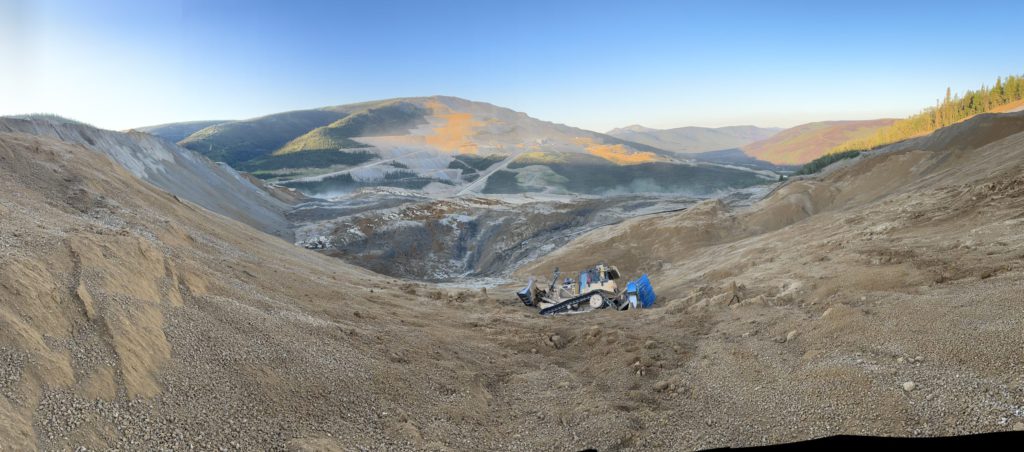Colin McClelland - The Northern Miner | July 31, 2024 |


An equipment operator’s bulldozer was pulled into the landslide at Victoria Gold’s Eagle mine on June 24. Submitted photo
Victoria Gold (TSXV: VGCX) says the danger of major contamination from its Eagle mine in the Yukon has passed and the company is financially solvent for now.

CEO and president John McConnell has spoken publicly for the first time in remarks to the CBC since a June 24 landslide of millions of tonnes of cyanide-laced ore stopped production and threatened local waterways. He apologized to employees, Yukoners and the Na-Cho Nyäk Dun First Nation.
However, McConnell says the company doesn’t agree with some efforts by the territorial government to step in with contractors to build a berm because it may create environmental and safety issues. But the company is helping the effort, he said. He made the comments in an interview the CBC aired on Tuesday.
It followed on the same day the company’s first printed statement since July 12, which said it continues to find “trace amounts” of cyanide, used in gold mining to separate the metal form ore, in a local creek. It’s proposing to send some of the contaminated water on site back to the heap leach pad so that containment ponds aren’t overwhelmed.
“The company and its third-party experts have determined that a modest irrigation strategy to the areas of the heap leach facility (HLF) that were not impacted by the HLF incident is a safe water management plan,” Victoria said.
It “will allow time for the company to augment water treatment and discharge capacity at site and will avoid direct discharge of untreated water to the environment,” the miner said.
Victoria Gold (TSXV: VGCX) says the danger of major contamination from its Eagle mine in the Yukon has passed and the company is financially solvent for now.

CEO and president John McConnell has spoken publicly for the first time in remarks to the CBC since a June 24 landslide of millions of tonnes of cyanide-laced ore stopped production and threatened local waterways. He apologized to employees, Yukoners and the Na-Cho Nyäk Dun First Nation.
However, McConnell says the company doesn’t agree with some efforts by the territorial government to step in with contractors to build a berm because it may create environmental and safety issues. But the company is helping the effort, he said. He made the comments in an interview the CBC aired on Tuesday.
It followed on the same day the company’s first printed statement since July 12, which said it continues to find “trace amounts” of cyanide, used in gold mining to separate the metal form ore, in a local creek. It’s proposing to send some of the contaminated water on site back to the heap leach pad so that containment ponds aren’t overwhelmed.
“The company and its third-party experts have determined that a modest irrigation strategy to the areas of the heap leach facility (HLF) that were not impacted by the HLF incident is a safe water management plan,” Victoria said.
It “will allow time for the company to augment water treatment and discharge capacity at site and will avoid direct discharge of untreated water to the environment,” the miner said.
Moratorium
Some 4 million tonnes of ore slid down a steep embankment at the Yukon’s only gold miner about 375 km north of Whitehorse. About 280,000 cubic metres of cyanide-containing solution cascaded down with the landslide, according to government estimates.
Local contamination appears to be limited to one creek and the government is helping with the cleanup. The local First Nation has called for a moratorium on all mining in its traditional territory.
Victoria Gold is sound financially for at least four to six months, but would then likely need financing, McConnell told the CBC. The company faced debt payments of C$232.5 million as of March 31, according to its first-quarter financial report.
Shares in the miner fell 2.6% to C$0.565 apiece in Toronto on Wednesday morning, valuing the company at C$38.3 million. The stock lost about 85% of its value after the accident.
Victoria said it detected minor amounts of weak acid dissociable (WAD) cyanide, a designation that includes different forms of the toxin, in seven of 134 samples collected as of July 23 in Haggart Creek downstream from the site.
The results range from concentrations of 5.2 to 9.3 parts per billion WAD cyanide. Victoria’s water use licence allow 5 parts per billion WAD cyanide, while federal guidelines for drinking water permit as much as of 200 parts per billion free cyanide, the company said.
Seismic study
The company says it’s conducted a seismic survey to help assess the integrity of the heap leach pad’s embankment and it’s increased its geotechnical monitoring. There’s been no significant material movement on the pad since the accident, it said.
It’s completing the construction of lined containment ponds and has increased water treatment capacity on site. The ponds were delayed by materials held back in a road closure south of Whitehorse while the mine has imported chemicals and equipment from Texas and elsewhere to help with water treatment, McConnell told the CBC.
McConnell said it was too early to determine the exact cause of the accident. The company has appointed a three-person panel of experts, two of them experienced with heap leaches, the other a hydrochemist who’s been involved in similar investigations, the CEO said in the interview. Their names will be confidential until a report is released in about four to six weeks, he said.
No comments:
Post a Comment